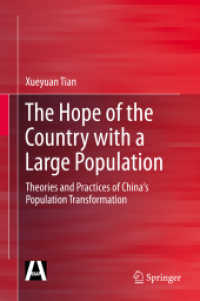- ホーム
- > 洋書
- > 英文書
- > Computer / General
Full Description
Artificial Humanities explores how literature, history, and art can deepen our understanding of artificial intelligence and its development. By examining fictional representations of AI in parallel with actual technological developments, Nina Beguš presents a novel interdisciplinary framework for understanding the cultural, philosophical, and ethical dimensions of AI. She traces connections from Eliza Doolittle to ELIZA the chatbot and current language models, incorporates Slavic fictional examples from the Pygmalion paradigm, and compares mid-century science fiction and recent Hollywood films with contemporary developments in social robotics and virtual beings.
Highlighting the impact of human-like AI design, from gendered virtual assistants to romanticized social robots, the book shows how these technologies intersect with longstanding humanistic questions about the concepts of creativity and language as well as the relations between humans and machines. Additionally, the book explores AI's applications in medical fields, particularly psychiatry and neurotechnology, including how AI interacts with the human body and mind to address conditions like paralysis. By emphasizing the philosophical and cultural implications of these technologies, Beguš highlights the need for responsible innovation that prioritizes human well-being as well as machine potential outside of human imitation. Accessible and thought-provoking, Artificial Humanities offers tools for analyzing and assessing technologies while they are being developed and invites readers to see how the humanities can guide us toward a more thoughtful future for AI.
Contents
Table of Contents
Introduction: The Pygmalion Myth in Technology
What is artificial humanities?
When Machine Speaks
The History of the Pygmalion Myth
When Galatea Speaks
Overview of the Book
Chapter 1: Inventing New Elizas
1.1 Shaw's Heritage
1.2 The Turing Test
1.3 The Eliza Effect
1.4 Relationality
1.5 Becoming Human
1.6 Language-Centeredness in AI
1.7 Machine Speech Training
1.8 Artificial Humanities: Language Enhancement
Chapter 2: Illusions of Social Robotics
2.1 Social Robots: Hanson's Sophia
2.2 Pygmalion's Perspective
2.2.2 Periphery: Šeligo
2.3 Both Sides Now: Nešković
2.3 Galatea's Perspective
2.3.1 Speak, Galatea: Feminist Authors
2.4 Nonhuman Perception: Lem
2.5 Artificial Humanities: In Search of the Nonhuman
2.5.1 Linguistic Execution: Jonze
2.5.2 Visual Execution: Garland
Chapter 3: Pygmalionism and Paralysis in Medical Ethics
3.1 Pygmalionism in the Medical and Legal Literature
3.1.1 Literary References
3.1.2 Sexology
3.1.3 Law
3.1.4 Psychology
3.2 Modern Pygmalions
3.2.1 Virtual Beings
3.2.2 Pygmalionesque Psychotherapy: Gillespie
3.3 Galatean Paralysis
3.3.1 Moore
3.3.2 Sheldon
3.4 Literature and Medical Ethics
3.4.1 Locked-in: Vigand and Bauby
3.4.2 Asimov and Technology Ethics
3.5 Artificial Humanities: Building Ethically
Chapter 4: Language in Humans, Hybrids, and Machines
4.1 Humans: A Conceptual History of Language
4.1.1 A Commentary on Human Exclusivity in Language
4.2 Hybrids: Shelley
4.3 Machines: Powers
4.4 Artificial Humanities: Changing Concepts
Chapter 5: Machine Writing
5.1 Large Language Models
5.1.1 Structure is All You Need
5.2 Literary Market: Dahl
5.3 Literary Criticism: Tomažin
5.4 Writing Literature: Kehlmann and Allado-McDowell
5.5 Artificial Humanities: Centering Fiction
Conclusion: A Program for Artificial Humanities
6.1 AI Tropes
6.2 What Artificial Humanities Offers to STEM
6.3 The Role of Literary Studies
Bibliography
Primary
Secondary








